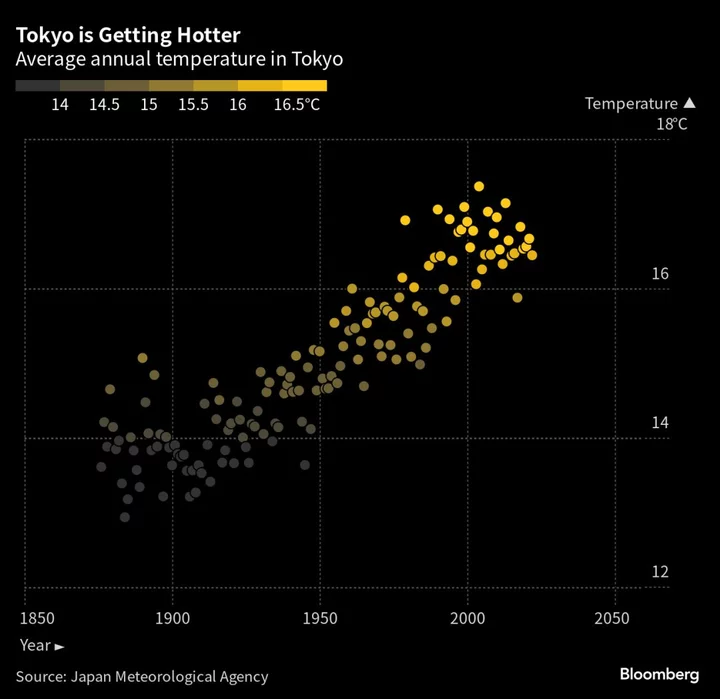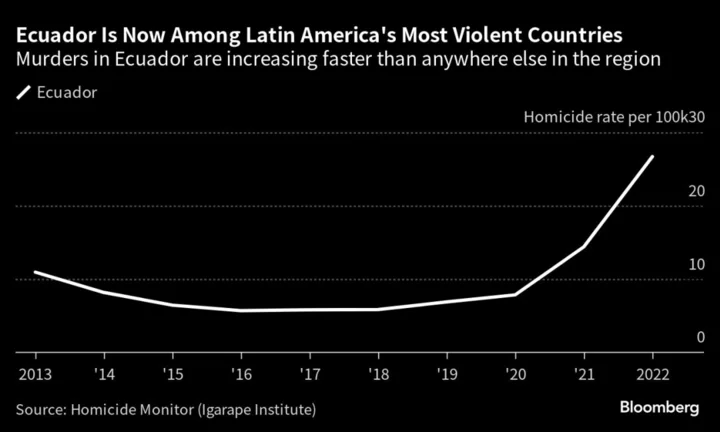Temperatures in central Tokyo have soared to nearly 9C (16F) above the seasonal average, as the extreme heat blanketing the world continues to smash historical norms.
Over the weekend, Japan’s government issued a fresh round of heatstroke warnings, encouraging people to avoid going outside and to check on at-risk neighbors. Japan is particularly vulnerable to extreme heat because it has one of the oldest populations in the world, with almost 30% of its citizens over the age of 65. Along with the very young, or ill, the elderly are typically at higher risk of suffering from heatstroke.
The hottest place in country was Kiryu, a city about two hours north of Tokyo, where the maximum temperature hit 39.7C over the weekend. Japan’s all-time record is 41.1C, according to the Japan Meteorological Agency.
While long-run historical data shows Tokyo has been getting warmer for decades — the average annual temperature has increased by about 3C over the past 100 years — this year’s unseasonable heat is supercharging that trend.
In central Tokyo, maximum temperatures reached 36.2C on Monday, 7C above the average for the season, according to data from JMA tracing back to 1875 analyzed by Bloomberg. What’s more, Tokyo is seeing an extended hot spell. Last Wednesday, the mercury reached 37.5C — that’s 8.9C above the average for the season.
Getting Warmer
As well as climate change, Tokyo is also affected by the urban heat island phenomenon, which occurs when cities are covered by high concentrations of buildings and roads that trap heat, according to the Tokyo Metropolitan Government’s Bureau of Environment.
Although Tokyo “doesn’t have the kind of high rise that you might get say in Manhattan” the city’s “medium density buildings, if they’re clustered fairly close together and there’s not much green space cover, they will trap heat and release it slowly as well,” said Jason Byrne, a professor of human geography and planning at the University of Tasmania.
While Japan is far from alone in facing rising temperatures — the Italian islands of Sicily and Sardinia are expected to test Europe’s all-time high above 48C this month, according to the European Space Agency — the issue is particularly acute due to its rapidly aging population. In 2020, 86% of heat wave deaths in Japan were above the age of 65, according to the environment ministry.
In May, Japan’s cabinet approved a plan to try and reduce the number of heatstroke-related casualties, including measures such as pushing local municipalities to set up AC-equipped cooling shelters. For those groups like construction workers that have little choice but to work outside, clothing with built-in fans is common.
Days with temperatures over 35C are categorized as moushobi in Japanese by the meteorological agency, which literally translates to “extremely hot day.” Those numbers have been increasing in the recent decades.
In some cases, the heat island effect can be so strong that buildings fail to cool down at night, which may force people to run air conditioners throughout the evening. Those who can’t afford to may encounter difficulty sleeping, leading to elevated stress levels and physiological impacts over multiple nights during a heat wave.
If the urban environment stays hot throughout the night and into the early mornings, “that’s when you start to get those levels of heat-related stress and elevated excess deaths and morbidity from urban heat,” Byrne said.
--With assistance from Kevin Dharmawan.
Author: Shoko Oda, Yasufumi Saito and Aaron Clark









